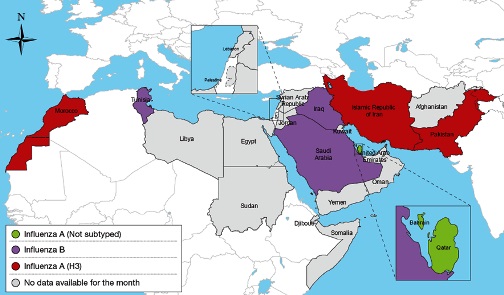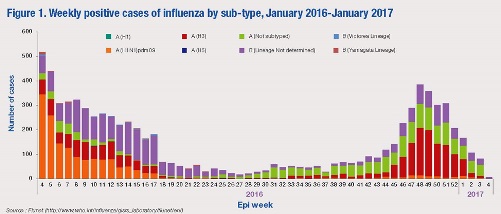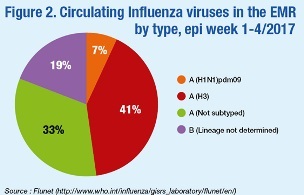16 February 2017 – This monthly update provides information on the circulating pattern of influenza viruses and highlights abnormal influenza virus activities in the countries of WHO’s Eastern Mediterranean Region. It compares circulating patterns in the Region with previous seasons and present the pre-dominating influenza viruses circulating in countries (Map 1).
Map 1. Circulating influenza viruses in the Eastern Mediterranean Region, January 2017

Disclaimer: The presentation of material on the maps contained herein does not imply the expression of any opinion whatsoever on the part of the World Health Organization concerning the legal status of any country, territory, city or areas or its authorities of its frontiers or boundaries. Dotted lines on maps represent approximate border areas for which there may not yet be full agreement.
Influenza activity by sub-type
-
Influenza activity for the 2016–2017 season started early compared to the previous season, starting during EPI week 43–44. High levels of activities were observed during week 48–49. Since week 52, influenza activities have remained low.
-
In northern Africa (Morocco and Tunisia), during the month of January, the predominant virus was influenza B virus. In the Middle East (Bahrain, Iraq and Qatar) both influenza A and B virus have been co-circulating. In southern Asia (Pakistan and Islamic Republic of Iran) the predominant circulating virus is Influenza A (H3) virus. (Figure 1).

Circulating influenza viruses by sub-type
-
In January 2017, influenza A(H1N1)pdm09, influenza A(H3N2), and influenza B viruses were detected in the Region with marked variations in different transmission zones.
-
Influenza A(H3) comprised 41% of all detected viruses in the Region; 33% of detected viruses were influenza A(not sub-typed). Influenza B (19%) and influenza A(H1N1)pdm09 (7%) were the other viruses detected in the Region.





